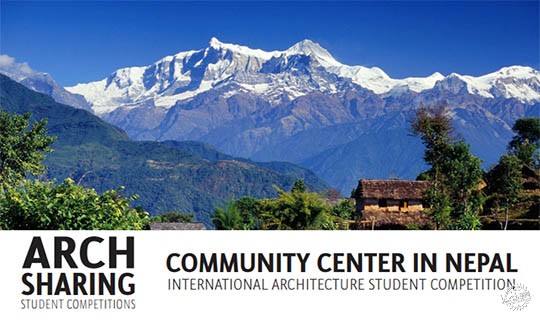
Community Center in Nepal
由专筑网缕夕,李韧编译
提交日期:2018年5月9日
注册日期:2018年5月6日
语言:英语、西班牙语、法语
地点:尼泊尔
奖励: 请参阅下面的细节
类型:学生竞赛和年轻建筑师
尼泊尔位于中国和印度之间,毗邻喜马拉雅山脉,坐拥美丽的风景与世界八大山峰之一。尼泊尔经济的重要来源是当地的旅游业,该收入比例至少占该国国内生产总值的10%。虽然地理资源优势得到了很好的开发利用,但其地理环境复杂、地形多变、气候环境恶劣,其季节性自然现象让许多旅行者望而却步。
其民族、社会等级和语言的多样性使尼泊尔的文化更加丰富。迷信和宗教信仰是尼泊尔日常生活的重要组成部分,当地信奉印度教的信徒非常多,印度教与佛教并存数百年。尼泊尔的建筑、文化和宗教紧密相连,最美丽的艺术作品都存在于寺庙之中。今天的城市和乡村仍然有浓厚的宗教色彩。
尼泊尔有2900万居民,85%以上的人口居住在农村。尼泊尔分为75个地区,有着与城市相对应的“VDC”(村发展委员会)。村庄的结构因地而异。有些是由密集的房屋组成,有些则更为分散,房屋彼此分开。随着时间的流逝,感受也不尽相同,有时村庄与村庄之间甚至距离几个小时的路程。这些村庄与主要城市的关联甚少,导致当地教育无法发展。但在尼泊尔人口中仍有多数的年轻人。
尼泊尔长期以来一直受益于其独特的地理位置,这里是商人和旅行者的必经之地。今天,与邻国的发展相比,它相对落后。当地发展面临许多挑战:饮用水、电力设备、通信基础设施、废水管理、交通基础设施等等。但是,这些问题在过去几年中有了很大的改善。全国大部分地区的电力系统都相对稳定,即使在真正落后的村庄,通信基础设施也有所保障。
尼泊尔过去十年来经历了经济和政治危机,但最大的难关是从2015年4月25日和5月12日遭受的严重地震灾害。在加德满都的周围地区,大量建筑遭到破坏,造成9000多人死亡。
在这场灾难之后,国际援助团队共同合作重建家园。经多方共同合作,尼泊尔得以重新发展起来。两年之后,一些非政府组织便将重心放在其他任务上,因此尼泊尔当地的困境仍在持续。
在此背景下,ARCHsharing与Rook'n Wood组织合作,邀请参赛者设想在离加德满都20公里的地区建设一个社区中心。
目标是建设基础设施,改善居民的日常生活。它应当具有实用性,需设置有社区工作室、厨房、媒体/文化空间和浴室(淋浴间和厕所)。
获胜者将有机会与Rock'n Wood组织继续合作。
参赛资格
建筑相关专业的在校生,以及从业时间在3年之内的新兴建筑师均可报名。团队可以由多学科成员组成(建筑师、工程师、园艺师,...)。在注册时,需要出示官方证明(如学生证、文凭等)。
作品提交要求
参赛者将提交两种类型的文件。其一为A1尺寸(横向或纵向)的JPG文件,和一个A4尺寸的设计说明。A1展板应包含能让人正确理解项目所需的所有图形元素。表现形式不限(平面、剖面、3D、轴测、模型...)。文件必须是JPG格式,文件名称不能超过10个字符。文件名称将遵循以下模板:TEAMCODE_A1_CCN(例如:ACS_A1_CCN)。方案说明文件要求简明扼要,不超过一页A4页面。字体应为Arial 12,文件命名注意名称应遵循以下模板:TEAMCODE_A4_CCN(例如:ACS_A4_CCN)。
为了让参赛者更充分地了解任务要求,主办方将提供以下文件:
任务书的简单说明
- 建筑场地和尼泊尔的照片
- CAD文件(autocad和Archicad)
- 文件提交模板(A1和A4)
- 竞赛海报
竞赛网站:https://www.arch-sharing.com/home-en
Submission: May 09, 2018
Registration: May 06, 2018
Language: English, Spanish, French
Location: Nepal
Prizes: Please see details below
Type: student competition and young architects
Located between China and India, Nepal is all along the Himalayas. These high mountains offer a range of beautiful landscapes with the eight highest summits of the world. Nepal gets an important profit from the hiking tourism, which represents at least 10% of the GDP of the country. Although well exploited by the country, its environment is a difficult aspect for its development with a complex topography and a rough climate. Seasons rhythm the country’s activities with dry winter and summer marked by important monsoons.
The diversity of its ethnic groups, its castes, and its languages contribute to the richness of the culture of this country. Cults and religions take an important part of the Nepalese daily life; Hinduism, practiced by the majority of the population, has been coexisting with Buddhism for centuries. Architecture, culture and religion are tightly connected in Nepal, where the most beautiful wood or rock sculptures mainly stand in temples and monasteries. Nowadays cities and villages still come alive at the rhythm of religious festivities.
With 29 million inhabitants, more than 85% of the population live in rural area. Nepal is divided in 75 districts, then in «VDCs» (Village Development Committee) who correspond to municipalities. Villages’ structure can differ from one place to another. Some are composed by groups of houses, with a dense typology. Other are more scattered, with houses separated from each other. Time perception is felt differently: it is common to have to walk for a few hours to walk across a village. These villages are sometimes badly connected or even not connected at all to the main cities, which is why education has been hard to access for a long time. Nowadays an important improvement is visible, with 84% of alphabetization in the young population.
Nepal has been benefiting of its geographic situation between its bordering countries for a long time, being a natural stop for merchants and travellers. Today, it is left behind as compared to its neighbours. There are many challenges to development: drinkable water, electricity support, communication infrastructure, wastewater management, infrastructure for transportation… However, these last years, some aspects of the development have been considerably improved. Electricity support became constant in the major part of the country and communication infrastructure have improved even in really retreated villages.
During the last ten years, Nepal has got through economic and political crisis, but its biggest challenge is to recover from the terrible earthquake that has devastated part of the country on 25 April and 12 May 2015. In the area around Kathmandu, earthquakes have destroyed a huge amount of constructions and caused more than 9000 deaths.
In the aftermath of this disaster, international assistance has worked together to rebuild the country. The outcome was positive but not to the scale of the real needs. Two years after, the mains NGOs are leaving to other assignments, but the damage is still present.
In this context, ARCHsharing, in partnership with Rook’n Wood NGO, invites participants to imagine the construction of a community center in an area 20km away from Kathmandu.
The goal is to propose a useful infrastructure which improves the daily life of the inhabitants. It shall be a community a building serving several of the village’s unaddressed needs. The facility will provide a community room, an atelier, a kitchen, a media/cultural space and bathroom (shower and toilets).
The winner will get the opportunity to build his/ her project with Rock’n Wood humanitarian NGO.
ELIGIBILITY
Registration is open to all students of schools and universities in relation with architecture, and to young architects less than three years after graduation. Teams can be multidisciplinary (architect, engineer, landscaper, …). An official proof will be asked during registration (student card, diploma, …).
DELIVERABLES
Participants will submit two types of documents. One panel, A1 size, (landscape or portrait), and one explanatory notice, A4 size. The A1 panel shall contain all graphical elements needed for a proper understanding of the project. Any kind of representation is accepted (plan, section, 3D, axonometry, models, …). Files must be JPG format and no bigger than 10 Mo. File names will follow this template: TEAMCODE_A1_CCN (example: ACS_A1_CCN). Explanatory notice will be clear and concise, no longer than one A4 page. Font shall be Arial 12. Notice name shall follow this template: TEAMCODE_A4_CCN (example: ACS_A4_CCN).
For the good understanding of the participants, the following documents will be given:
-Brief stating the objective for the works
-Photos from the site and from Nepal
-Map for the plot of land (autocad and Archicad)
-Templates for submission (A1 & A4)
-Poster for the competition
competition’s website: https://www.arch-sharing.com/home-en
出处:本文译自competitions.archi/,转载请注明出处。
|
|
